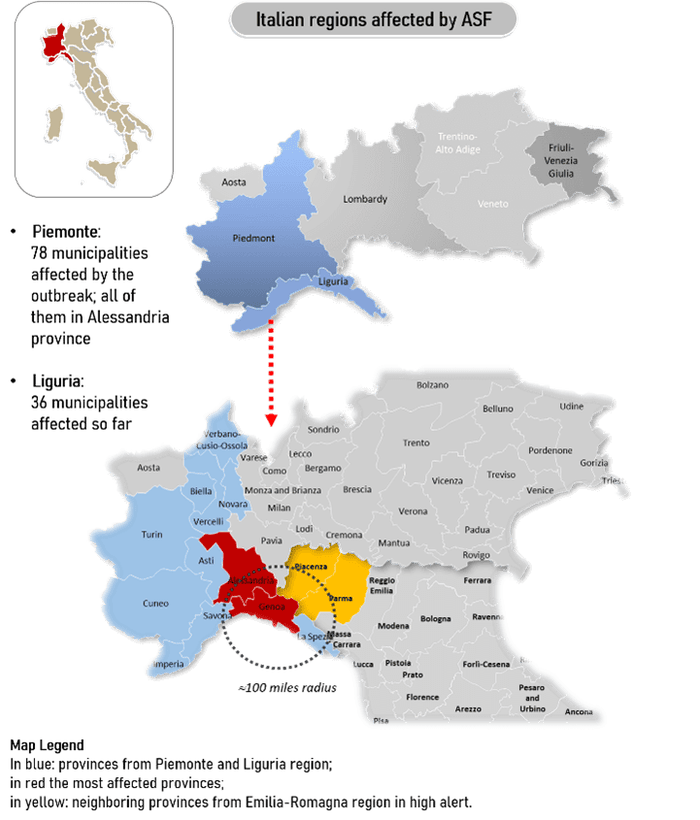Following finding of a dead wild boar in northern Italy, positivity for genotype 2 was reported; same strain of African swine fever circulating in Europe.
January 14, 2022

African swine fever has been diagnosed in Italy. A dead wild boar found in Ovada, in the province of Alessandria, was found to have ASF, per the Italian news wire service ANSA on Jan. 7, and subsequently confirmed by OIE, the World Organization for Animal Health. Since this first ASF diagnosis was reported, others have been found. Per an Italian news report, there are five cases and the number of municipalities in the infected area rose to 114 overall, 78 in Piedmont and 36 in Liguria. These were all included by the Ministry of Health in the ASF control zone as required by European Commission protocol.
The outbreak report posted by OIE on Jan. 10 said, "Following the finding of a dead wild boar in northern Italy, the positivity for genotype 2 is reported, the same strain currently circulating in Europe, that characterizes the epidemic wave that began in 2007." Also on Jan. 10, the EC said Italy will need to ensure that an infected zone for ASF is established immediately and also ensure that consignments of porcine animals kept in the areas listed as an infected zone in the Annex and products thereof are not authorized for movements to other Member States and to third countries. These restrictions currently apply until April 7.
The Swine Health Information Center, American Association of Swine Veterinarians, National Pork Board and National Pork Producers Council have been gathering information about whether the presence of ASF in Italy, and the response there, could increase risk to the U.S. swine herd or affect the movement of pork products exported from Italy. The U.S. has an agreement with the European Union to recognize the EU response and the application of control zoning in Italy, as in other affected EU countries. And the zoning and control actions underway in Italy, taken in response to this ASF diagnosis per the EU directive, apply to Member States and third countries, so they apply to products destined for the United States.
USDA-Food Safety Inspection Service informs USDA-Animal Plant Health Inspection Service with map locations of slaughter facilities approved for export to the United States and, thus far, no facilities are located within the control area. In addition, as a condition of export, the facilities must attest that slaughtered animals do not come from, or travel through, the affected area. Also, facilities processing Parma hams are not located in the affected area, as in the United States no clinically sick pigs are allowed for slaughter and the extended Parma ham curing process has been shown to mitigate ASF risk from the meat.
Map 1 gives some perspective about the geographical scope of the outbreak, so far.

According to OIE, ASF has been found in North Macedonia and the occurrence is not connected to the case in Italy. Per OIE's report, clinical signs were noticed by the farmer on Dec. 29 and dead cases were reported on Jan. 1, in a small backyard farm located in the eastern part of country. On Jan. 5, blood samples, swabs and organs were submitted for analysis. Positive results for ASF were obtained Jan. 6, via real time PCR in the Laboratory of Faculty of Veterinary Medicine, Skopje. According to the epidemiological investigation, possible entrance of the disease was contact with wild boars. The Food and Veterinary Agency issued a decision on Jan. 7, regarding protective and control measures, establishing protection zone of 3 kilometers and surveillance zone of 10 km with accompanying measures that will apply to holding zones. A stamping out policy was carried out among all pig holdings in the 3 km area on Jan. 10.
And while Thailand hasn't officially notified the OIE of an ASF outbreak, several press reports indicate a case was found in a slaughterhouse. The complex, evolving situation will continue to be closely monitored.
SHIC, launched by the National Pork Board in 2015 solely with Pork Checkoff funding, continues to focus efforts on prevention, preparedness and response to novel and emerging swine disease for the benefit of U.S. swine health. SHIC is funded by America's pork producers to fulfill its mission to protect and enhance the health of the U.S. swine herd.
You May Also Like



